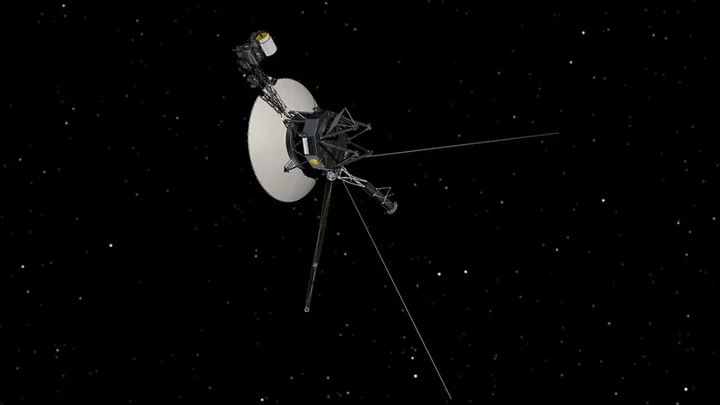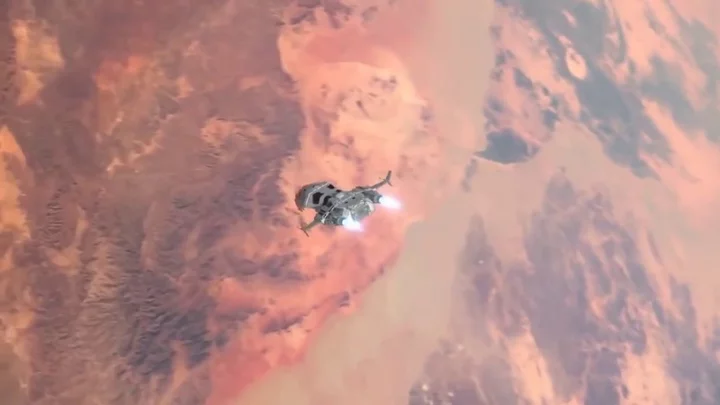
Steve Wozniak’s Privateer Is Forging an Online Market for Satellite Access
Steve Wozniak’s space startup Privateer is launching a global online marketplace that aims to connect customers seeking planetary
2023-08-01 22:22

Nasa Voyager 2: Space agency accidentally loses contact with pioneering space probe
Nasa has “inadvertently” lost contact with Voyager 2, its pioneering spacecraft. The space agency said that it had sent a series of planned commands to the probe on 21 July. But those moves left Voyager 2 pointing in the wrong direction: its antenna is now pointing two degrees away from Earth, and so it has lost contact with its engineers. It cannot either receive commands or send back data, Nasa said. Ordinarily, it would do so by establishing contact with the Deep Space Network, or DSN, which is a set of ground-based antennas that allow for communications with distant spacecraft. But the data being sent by Voyager 2 is not reaching that network. Voyager 2 is now floating on its own, almost 20 billion kilometres from Earth. Nasa still hopes to be able to re-establish contact with the probe, however. It is programmed to automatically reset its orientation a number of times each year, to push its antenna back to Earth. The next reset is expected to happen on 15 October, Nasa said. Until then, the space agency expects the probe to “remain on its planned trajectory during the quiet period”, it said. As its name suggests, Voyager 2 was part of a pair, both of which were launched in 1977. Voyager 1 is floating even further from Earth – at 24 billion kilometres – and Nasa says it is continuing to operate as normal. The Voyager programme brought with it a host of records: Voyager 2 is the only spacecraft to have visited Uranus and Neptune, and together they are the only spacecraft made by humans to ever have entered interstellar space. Even almost 50 years since they were launched, the pair of Voyager spacecraft have continued to send back useful and important information to Nasa for examination by scientists on Earth. They have contributed to a host of new findings about the very distant edges of our solar system. Read More How to take the perfect picture of tonight's supermoon Elon Musk installs huge, glowing letter on top of his office A game where you go to sleep in real life is one of the most popular in the world
2023-08-01 01:18

The 'doomed Phobos moon' is about the crash into Mars
When NASA’s Perseverance Rover observed an image from Mars of its moon Phobos eclipsing the Sun, it was a reminder that the astronomical body is doomed to crash into the planet. Phobos is the closest of Mars’ two moons and it is due to fall out of orbit relatively soon. When it does, it will either crash into the surface of the planet or break up completely. Before it does, it will drift ever closer to Mars at a relatively rapid rate. "Phobos is nearing Mars at a rate of six feet (1.8 meters) every hundred years; at that rate, it will either crash into Mars in 50 million years or break up into a ring," NASA says about the moon. Sign up to our free Indy100 weekly newsletter A statement about the recently recorded eclipse states: "Scientists already know that Phobos is doomed. “The moon is getting closer to the Martian surface and is destined to crash into the planet in tens of millions of years. But eclipse observations from the surface of Mars over the last two decades have also allowed scientists to refine their understanding of Phobos’ slow death spiral." NASA's Perseverance Rover Sees Solar Eclipse on Mars www.youtube.com Mars is the subject of much scientific interest right now, especially after Nasa discovered “diverse organic matter” on the surface of the planet, which could change our understanding of the red planet and the search for life in the universe. The Perseverance rover made the discovery in the Jezero Crater on Mars and a number of different explanations for the existence of the material have been posited. The materials could have been formed when water and dust interacted, or was dropped onto the planet by dust or meteors. Have your say in our news democracy. Click the upvote icon at the top of the page to help raise this article through the indy100 rankings.
2023-07-31 20:52

OceanGate founder now wants to send people to least hospitable planet in the galaxy
The co-founder of the OceanGate is now planning to send 1000 people to Venus despite the bad press the company has received following the doomed Titanic submersible trip in June which killed five people. Despite the tragedy, which saw the submersible implode killing everyone onboard, including the company's co-founder Stockton Rush, his colleague Guillermo Söhnlein is not deterred and has told Insider that he now has ambitions for space. According to Söhnlein he now wants to see 1000 people living on the surface of Venus, the hottest planet in the solar system, by 2050. The American businessman born in Argentina said: "I think it is less aspirational than putting a million people on the Martian surface by 2050. Sign up to our free Indy100 weekly newsletter "You're absolutely right that when you talk about going to Venus, it would raise eyebrows outside the space industry. And it even raises eyebrows inside the space industry." "I think I've been driven to help make humanity a multi-planet species since I was 11 years old, I had this recurring dream of being the commander of the first Martian colony." This all sounds well and good and after all Elon Musk has similar aspirations for Mars but Venus is an odd one as at this moment in time its one of the least hospitable planets in the galaxy. Aside from being the hottest planet in the solar system, as mentioned, its atmosphere is made up of greenhouse gases and its clouds contain sulphuric acid which make Venus so hot that temperatures can reach 475 °C. Regardless of this, Söhnlein thinks it is "very doable" that a floating space station could withstand the harsh conditions on Venus but will likely be met with skepticism. Söhnlein's Humans2Venus project has been co-founded with researcher Khalid Al-Ali and will strive to develop technologies that will reduce launch costs and fund space projects without government money. Have your say in our news democracy. Click the upvote icon at the top of the page to help raise this article through the indy100 rankings.
2023-07-30 16:15

New ocean discovered that is beginning to split Africa in two
Since the break up of Pangea that formed the world, we have been taught that there are seven oceans. But now, scientists believe a brand new ocean is currently forming as the continent of Africa is slowly beginning to split in half. Researchers have found two large parts of the land within Africa have begun to separate and it's believed a whole new ocean will form in the divide. Africa is the second-largest continent in the world, with a landmass of more than 30 million square kilometres, and is also the second-most populous. Many of its 54 countries are landlocked, however for some that could be about to change. Geologists believe countries such as Uganda and Zambia could come to have their own coastlines if the two land masses continue to separate. In the peer-reviewed journal, Geophysical Research Letters, experts have confirmed that the split in the African continent is creating a way for a new ocean to form. Sign up to our new free Indy100 weekly newsletter Scientists have identified the exact location where the continent first started to split, very deep underground. The crack first began to appear in 2005 in Ethopia’s deserts. The crack is known as the East African Rift and is 35 miles long. The start is positioned at the meeting point of three tectonic plates which have been gradually pulling apart from each other. Christopher Moore, a Ph.D. doctoral student at the University of Leeds, told NBC News: “This is the only place on Earth where you can study how continental rift becomes an oceanic rift.” Moore and other researchers have used satellite radar to monitor the volcanic activity in East Africa as this is associated with tectonic shifts. Despite being able to monitor movement, the split is a very gradual process, and scientists believe it will take another 5 to 10 million years for the new ocean to fully form. Have your say in our news democracy. Click the upvote icon at the top of the page to help raise this article through the indy100 rankings.
2023-07-29 23:57

Scientists Have Created the Whitest Paint Ever—and It Might Help Cool the Planet
The ultra-white paint can block up to 98 percent of the sun's rays. Applied on roofs, it could have a dramatic cooling effect on homes and buildings.
2023-07-29 03:16

There’s a perfectly good reason why people believe conspiracy theories
Ever wondered why certain people are more likely to believe conspiracy theories than others? A study has been conducted with the express aim of finding the specific personality traits that cause people to buy into certain theories – and the results go against the sentiment that it’s down to lack of education or knowledge. Shauna Bowes of the Emory University clinical psychologist expressed that there are sometimes complex reasons why people choose to believe them. "Conspiracy theorists are not all likely to be simple-minded, mentally unwell folks – a portrait which is routinely painted in popular culture," says Emory University clinical psychologist Shauna Bowes. Sign up to our free Indy100 weekly newsletter "Instead, many turn to conspiracy theories to fulfil deprived motivational needs and make sense of distress and impairment." The research, which was published in the Psychological Bulletin, involved 170 studies mainly from the US, UK, and Poland and looked into the reasons behind certain beliefs. The biggest reasons they found related to a desire in the subjects to feel safe and to be socially secure, as well as to understand their environment. "Our findings reveal that motivations at large are important, perhaps even essential, pieces of the conspiratorial ideation puzzle," the paper reads. Lower analytical thinking did have a significant correlation to believing conspiracies, but it was actually individual and collective narcissism, and a need to feel unique which had a stronger link. "These results largely map onto a recent theoretical framework advancing that social identity motives may give rise to being drawn to the content of a conspiracy theory, whereas people who are motivated by a desire to feel unique are more likely to believe in general conspiracy theories about how the world works," Bowes said. Have your say in our news democracy. Click the upvote icon at the top of the page to help raise this article through the indy100 rankings.
2023-07-28 23:19

Experts resurrect parasite after 46,000 years in Siberian permafrost
Scientists have resurrected a parasite which has been dormant in the frozen permafrost of Siberia for 46,000 years. The microscopic creatures were first uncovered as part of a remarkable discovery back in 2018. At the time, researchers led by Anastasia Shatilovich found two of the worms in sub-zero temperatures in the soil. At first, it was previously thought that the creatures could stay in their slumber for just 40 years. However, it was later revealed that they could stay inactive for tens of thousands of years. Sign up to our free Indy100 weekly newsletter The creatures tend to shut down their systems when they are in unfavourable conditions. This means they won’t move or reproduce, and their metabolism stops. Carbon analysis has revealed that the worms – also known as nematodes – came from a prehistoric era. The developments could change the way experts approach bringing back other extinct species, too. During an analysis, the research team discovered the worms were Panagrolaimus kolymaensis - a species that was previously thought to be extinct. The scientists wrote in their paper: “Previously, we had shown that nematodes from the Siberian permafrost with morphologies consistent with the genera Panagrolaimus and Plectus could be reanimated thousands of years after they had been frozen. “Several viable nematode individuals were found in two of the more than 300 studied samples of permafrost deposits spanning different ages and genesis.” It’s not the only thing that scientists have recovered from permafrost, either. It was announced earlier this year that scientists are busy working on reviving 'zombie viruses’ that have been lying dormant for tens of thousands of years in Arctic conditions, and while it sounds absolutely terrifying, it could be important when it comes to protecting us all in the future. Have your say in our news democracy. Click the upvote icon at the top of the page to help raise this article through the indy100 rankings.
2023-07-28 19:23

US Senate panel passes AM radio, ticket fee pricing bills
By David Shepardson and Diane Bartz WASHINGTON The U.S. Senate Commerce Committee approved legislation on Thursday to bar
2023-07-28 02:17

Scientists say people have the ability to 'smell' rain before it arrives
Ever wondered why people say they can smell rain before it rains? They are not pulling your leg - there is real science behind it. It is all because of petrichor, made up from the Greek words "petra", meaning stone, and '"ichor", which refers to the golden fluid that flows in the veins of the gods in their mythology. It basically means the the "smell of rain" with the phrase coined by Australian scientists Joy Bear and Richard Thomas in 1964. Jeff Weber, a meteorologist with the University Corporation for Atmospheric Research Unidata Program Center told the Mirror: "Petrichor is caused by oils derived from plants, primarily leaves, that accumulate over dry periods. These oils settle into soils or onto pavement over time and are released into the atmosphere by being disturbed by rainfall." According to the Met Office, the reason people claim to smell rain because it comes is because "when a higher humidity is experienced as a precursor to rain, the pores of rocks and soil become trapped with moisture forcing some of the oils to be released into the air". Sign up to our free Indy100 weekly newsletter Despite some being released before it actually rains, the strongest smell is released during. This is when raindrops landing on soil "trap tiny air bubbles on the surface which then shoot upward" and "burst out of the drop throwing aerosols of scent into the air where they are then distributed by the wind". The smell is produced by a soil bacteria which releases a chemical called geosmin, which provides an "earthy", musky or fresh aroma. Before it rains, a person might be able to smell the scent of ozone, or O3, which is a naturally present gas in the atmosphere which gets its name from the Greek word 'ozein', or smell. It sometimes indicate that a storm is on the way because pockets of gas are pushed down to ground level by winds. This means that those who are sensitive to the smells will likely be able to pick them up. So now you know. Have your say in our news democracy. Click the upvote icon at the top of the page to help raise this article through the indy100 rankings.
2023-07-27 23:23

Harrowing animation shows how Oppenheimer's atomic bomb worked
The release of Christopher Nolan’s Oppenheimer has generated a flurry of interest in the man behind the atomic bomb, Julius Robert Oppenheimer. The film tells the story of the physicist and his role in the Manhattan Project, which was the the codename given to the development of the A-bomb. Oppenheimer, who referred to himself as “death, destroyer of worlds”, was the figurehead of the project, which involved splitting the atom and the devastation wrought by two atomic bombs being dropped on Japan in 1945. Sign up to our free Indy100 weekly newsletter The first bomb was dropped on the city of Hiroshima on 6 August 1945. It killed tens of thousands of people. It was nicknamed Little Boy. Oppenheimer Atomic bomb How it Works | First Nuclear Bomb www.youtube.com A second bomb fell days later on the city of Nagasaki, this time nicknamed Fat Man. Historians believe more than 200,000 people died as a result of the events, with millions more severely affected. Now, YouTube channel AiTelly has produced a video of what exactly happens inside such a weapon to create such a wave of destruction. The animation shows that when the bomb falls, it activates a switch that triggers a trio of navy gun primers, which in turn ignite a charge inside the weapon. Four silk powder bags containing two pounds of cordite, an explosive powder, push the the uranium projectile forward at 300 metres-per-second. The uranium collides with more uranium at the front of the bomb, combining them with four polonium initiators, which create nuclear fission. This is the act of splitting the atom, and it is what creates the huge expulsion of energy – the explosion. Have your say in our news democracy. Click the upvote icon at the top of the page to help raise this article through the indy100 rankings.
2023-07-27 21:56

A meteor which exploded over the Atlantic had similar force as Hiroshima atomic bomb
A meteor exploded over the Atlantic Ocean at a force comparable to the atomic bomb dropped on Hiroshima during the Second World War. While this may sound like a scary prospect, there is nothing to worry about as this asteroid did not actually hit the Earth. The debris burned up at a height of around 31 kilometres above the Atlantic Ocean off the coast of Brazil, experts say. Data from NASA showed that the meteor appeared to release the equivalent energy of around 12,000 tonnes of TNT - that's approximately 12 kilotons of explosive power. Sign up to our free Indy100 weekly newsletter Similarly, the Hiroshima Bomb detonated with an approximate energy of 15 kilotons – that is, 15 thousand tonnes of TNT equivalent. This force caused devastation in the Japanese city and killed at least 80,000 people instantly, with tens of thousands dying later due to radiation exposure. Although 12 kilotonnes does sound like a lot, there have also been other explosions that have had a higher number than this. One example is the 450 kilotons of explosive energy (0.45 megatons) released as a result of the Chelyabinsk meteor back in 2013 - 26 to 33 times as much energy as the Hiroshima Bomb. The house-sized asteroid exploded 14 miles above the ground and generated a shock wave that blew out windows over 200 square miles and damaged some buildings. Over 1,600 people were injured in the blast, mostly due to broken glass, according to NASA. Elsewhere, amazing footage captures the moment a meteor crashes into the moon and, scientists discover a secret planet hiding in our solar system. Have your say in our news democracy. Click the upvote icon at the top of the page to help raise this article through the indy100 rankings.
2023-07-27 21:16
